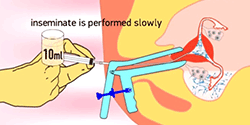With 10 ml of culture medium with the spermatozoa, while the classic insemination is performed with only 1 ml.
With this new insemination method, the spermatozoa are dynamically pushed to the fertilization sites (fallopian tubes, Puch of Douglas) where they meet the eggs, maintaining their fertilizing capacity, while at the same time the fallopian tubes are flushed (flushing) which increases pregnancy rates. This procedure is achieved by sealing the cervix, by a specially designed, in our Center, device which is a global innovation. (Ray A, RBMOnline 2012)
For more information watch the video:
Insemination is considered a first choice method before the couple proceed to IVF. 65% of infertility cases (unexplained infertility 30%, mild male infertility 25% and mild endometriosis 10%) can be successfully treated with insemination. The World Health Organization (WHO) and NICE NHS UK recommend 6 insemination attempts before IVF. The same opinion is shared by many scientists, experts such as Tournaye H. (2012), Ahinko-Hakamaa K. (2007). In this way, the physical, mental and financial burden on the couple is avoided.
Latest article in the prestigious medical journal, Human Reproduction Update, April 2024 reports a review study from Australia, the Netherlands and the United Kingdom. It is stated that intrauterine insemination with mild ovulation induction is usually considered first-line treatment for unexplained infertility, followed by IVF only if insemination is unsuccessful after several attempts. However, some Centers offer immediate IVF on the ground that IVF could reduce the emotional and physical burden on couples by shortening the time needed to achieve pregnancy.
Data from Australia, the Netherlands and the United Kingdom showed significantly higher costs associated with IVF compared to insemination. Previous studies have shown that although the success rates between IVF and insemination were about the same, most of the couples would prefer to continue with insemination beyond the first three cycles (van Weert et al., 2007; Bensdorp et al., 2016).
IUTPI intrauterine insemination offers high success rates, with low cost and milder medication. In our IVF Center 2 – 3 attempts are recommended before IVF.
Intrauterine tubalperitoneal insemination (IUTPI) is a new method of insemination with 10 ml of culture medium with the spermatozoa. Observations made during clinical application showed that in some cases, the 4 ml of injected sperm used in the method of FSP was not enough to pass through the fallopian tubes of the uterus because the intrauterine pressure exerted by the amount of 4 ml it wasn’t enough. Thus, the volume of the inseminate sperm was gradually increased, finally reaching 10 ml, while at the same time the intrauterine pressure was checked. The larger volume of inseminated sperm used, led to an unexpected increase in the pregnancy rate. In addition, 10 ml of contrast material is also used in hysterosalpingography to delineate the cervix, endometrial cavity, fallopian tubes along their entire length before reaching the intraperitoneal cavity and the Douglas space. Moreover, the potential therapeutic effect of hysterosalpingography has been extensively discussed in many articles in the last decade, since pregnancy rates increase after this procedure, especially in patients with unexplained infertility. There is a hypothesis that uterine fallopian osses are blocked by membranous elements, therefore, the 10 ml of inseminate sperm used in IUTPI is enough, to fill the uterine cavity, pass through the middle part of the fallopian tubes and finally reach the peritoneal cavity and the Douglas space, where they mix with the peritoneal and follicular liquid. In this way, endometrial-tubal-peritoneal infusion (IUTPI) is achieved. The excellent results of this method are published in the reproductive medical journal Fertility and Sterility in March 2006, at the Pan American Reproductive Congress (ASRM) in San Francisco (2008), at the International Reproductive Congress (IFFS) in Munich (2010), at the European Panco Andrology Congress of Athens (2010) etc. The method is used in various reproductive centers worldwide.
A new method of insemination with 10ml of inseminate. Observations in our clinical practice showed that, occasionally, the 4 ml of inseminate used for FSP was not sufficient to overcome the tubal ostia, because the intrauterine pressure caused by this volume was not adequate. Thus, a larger volume of inseminate was gradually used, ultimately reaching 10ml, while simultaneously checking the intrauterine pressure. There was an unexpected increase of pregnancy rates when a larger volume of inseminate was used. Besides, 10 ml of contrast medium is also used in hysterosalpingography (HSG). In addition, the possible therapeutic effect of HSG has been extensively discussed in various articles over the last decades, since the rate of live births increases after HSG, especially in patients with unexplained infertility, therefore, supporting the hypothesis that tubal “plugs” may be involved in proximal tubal blockage. The volume of 10 ml of inseminate was sufficient enough to fill the uterine cavity, pass through the interstitial part of the tubes and the ampulla, finally reaching the peritoneal cavity and the Pouch of Douglas where it would be mixed with the peritoneal and follicular fluids. In this way Intra Utero Tubo Peritoneal Insemination (IUTPI) was achieved. The promising results of IUTPI< the new L. Mamas insemination method, were published in the medical journal ‘Fertility and Sterility’, March 2006 issue (.pdf)
For more information on IUTPI please visit the website: www.iutpi.eu/en.html

